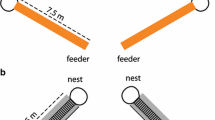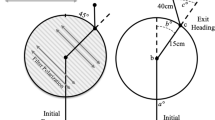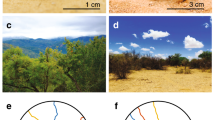Abstract
The Central Australian desert ant Melophorus bagoti is known to use celestial cues for compass orientation. We manipulated the available celestial cues for compass orientation for ants that had arrived at a feeder, were captured and then released at a distant test site that had no useful terrestrial panoramic cues. When tested in an enclosed transparent box that blocked some or most of the ultraviolet light, the ants were still well oriented homewards. The ants were again significantly oriented homewards when most of the ultraviolet light as well as the sun was blocked, or when the box was covered with tracing paper that eliminated the pattern of polarised light, although in the latter case, their headings were more scattered than in control (full-cue) conditions. When the position of the sun was reflected 180° by a mirror, the ants headed off in an intermediate direction between the dictates of the sun and the dictates of unrotated cues. We conclude that M. bagoti uses all available celestial compass cues, including the pattern of polarised light, the position of the sun, and spectral and intensity gradients. They average multiple cues in a weighted fashion when these cues conflict.



Similar content being viewed by others
References
Alais D, Burr D (2004) The ventriloquist effect results from near-optimal bimodal integration. Curr Biol 14:257–262
Batschelet E (1981) Circular statistics in biology. Academic Press, New York
Bühlmann C, Cheng K, Wehner R (2011) Vector-based and landmark-guided navigation in desert ants inhabiting landmark-free and landmark-rich environments. J Exp Biol 214:2845–2853
Cheng K (2012) Arthropod navigation: ants, bees, crabs, spiders finding their way. In: Zentall TR, Wasserman EA (eds) The Oxford handbook of comparative cognition. Oxford University Press, Oxford, pp 347–365
Cheng K, Shettleworth SJ, Huttenlocher J, Rieser JJ (2007) Bayesian integration of spatial information. Psychol Bull 133:625–637
Cheng K, Narendra A, Sommer S, Wehner R (2009) Traveling in clutter: navigation in the Central Australian desert ant Melophorus bagoti. Behav Process 80:261–268
Cheng K, Middleton EJT, Wehner R (2012) Vector-based and landmark-guided navigation in desert ants of the same species inhabiting landmark-free and landmark-rich environments. J Exp Biol 215:3169–3174
Christian KA, Morton SR (1992) Extreme thermophilia in a Central Australian ant, Melophorus bagoti. Physiol Zool 65:885–905
Collett M (2012) How navigational guidance systems are combined in a desert ant. Curr Biol 22:927–932
Collett TS, Collett M (2000) Path integration in insects. Curr Opinion Neurobiol 10:757–762
Collett M, Collett TS, Wehner R (1999) Calibration of vector navigation in desert ants. Curr Biol 9:1031–1034
Etienne AS, Jeffery KJ (2004) Path Integration in mammals. Hippocampus 14:180–192
Etienne AS, Maurer R, Berlie J, Reverdin B, Rowe T, Georgakopoulos J, Seguinot V (1998) Navigation through vector addition. Nature 396:161–164
Fent K, Wehner R (1985) Ocelli: a celestial compass in the desert ant Cataglyphis. Science 228:192–194
Heinze S, Reppert SM (2011) Sun compass integration of skylight cues in migratory Monarch butterflies. Neuron 69:345–358
Körding KP (2007) Decision theory: what “should” the nervous system do? Science 318:606–610
Körding KP, Beierholm U, Ma WJ, Quartz S, Tenenbaum JB, Shams L (2007) Causal inference in multisensory perception. PLoS ONE 2:e943
Lebhardt F, Koch J, Ronacher B (2012) The polarization compass dominates over idiothetic cues in path integration of desert ants. J Exp Biol 215:526–535
Lebhardt F, Ronacher B (2014) Interactions of the polarization and the sun compass in path integration of desert ants. J Comp Physiol A. doi:10.1007/s00359-00013-00871-00351
Merkle T, Wehner R (2009) Repeated training does not improve the path integrator in desert ants. Behav Ecol Sociobiol 63:391–402
Mote MI, Wehner R (1980) Functional characteristics of photoreceptors in the compound eye and ocellus of the desert ant, Cataglyphis bicolor. J Comp Physiol A 137:63–71
Müller M, Wehner R (2010) Path integration provides a scaffold for landmark learning in desert ants. Curr Biol 20:1368–1371
Muser B, Sommer S, Wolf H, Wehner R (2005) Foraging ecology of the thermophilic Australian desert ant, Melophorus bagoti. Austr J Zool 53:301–311
Narendra A (2007) Homing strategies of the Australian desert ant Melophorus bagoti I. Proportional path integration takes the ant half-way home. J Exp Biol 210:1798–1803
Narendra A, Cheng K, Wehner R (2007) Acquiring, retaining and integrating memories of the outbound distance in the Australian desert ant Melophorus bagoti. J Exp Biol 210:570–577
Pfeiffer K, Homberg U (2007) Coding of azimuthal directions via time-compensated combination of celestial compass cues. Curr Biol 17:960–965
Reid SF, Narendra A, Hemmi JM, Zeil J (2011) Polarised skylight and the landmark panorama provide night-active bull ants with compass information during route following. J Exp Biol 214:363–370
Ronacher B (2008) Path integration as the basic navigation mechanism of the desert ant Cataglyphis fortis (Forel, 1902) (Hymenoptera: Formicidae). Myrmecol News 11:53–62
Rossel S, Wehner R (1986) Polarization vision in bees. Nature 323:128–131
Santschi F (1911) Sur le mécanisme de l’orientation chez les fourmis. Revue Suisse Zool 19:303–338
Santschi F (1913) Comment s’orientent les fourmis. Revue Suisse Zool 21:347–426
Schultheiss P, Cheng K (2011) Finding the nest: inbound searching behaviour in the Australian desert ant, Melophorus bagoti. Anim Behav 81:1031–1038
Schultheiss P, Nooten SS (2013) Foraging patterns and strategies in an Australian desert ant. Austral Ecol 38:942–951. doi:10.1111/aec.12037
Schwarz S, Albert L, Wystrach A, Cheng K (2011a) Ocelli contribute to the encoding of celestial compass information in the Australian desert ant Melophorus bagoti. J Exp Biol 214:901–906
Schwarz S, Wystrach A, Cheng K (2011b) A new navigational mechanism mediated by ant ocelli. Biol Lett 7:856–858
Ugolini A, Galanti G, Mercatelli L (2013) Do sandhoppers use the skylight polarization as a compass cue? Anim Behav 86:427–434
von Frisch K (1948) Gelöste und ungelöste Rätsel der Bienensprache. Naturwissenschaften 35:38–43
von Frisch K (1949) Die polarisation des himmelslichtes als orientierender faktor bei den Tänzen der Bienen. Experientia 5:142–148
von Frisch K (1967) The dance language and orientation of bees. Belknap, Cambridge
von Saint Paul U (1982) Do geese use path integration for walking home? In: Papi F, Wallraff HG (eds) Avian navigation. Springer, Berlin, pp 298–307
Wehner R (1994) The polarization-vision project: championing organismic biology. Fortschritte Zool 39:103–143
Wehner R (1997) The ant’s celestial compass system: spectral and polarization channels. In: Lehrer M (ed) Orientation and communication in arthropods. Birkhäuser Verlag, Basel, pp 145–185
Wehner R (2003) Desert ant navigation: how miniature brains solve complex tasks. J Comp Physiol A 189:579–588
Wehner R (2009) The architecture of the desert ant’s navigational toolkit (Hymenoptera: Formicidae). Myrmecol News 12:85–96
Wehner R, Müller M (2006) The significance of direct sunlight and polarized skylight in the ant’s celestial system of navigation. Proc Nat Acad Sci USA 103:12575–12579
Wehner R, Srinivasan MV (2003) Path integration in insects. In: Jeffery KJ (ed) The neurobiology of spatial behaviour. Oxford University Press, Oxford, pp 9–30
Wehner R, Boyer M, Loertscher F, Sommer S, Menzi U (2006) Ant navigation: one-way routes rather than maps. Curr Biol 16:75–79
Wittlinger M, Wehner R, Wolf H (2006) The ant odometer: stepping on stilts and stumps. Science 312:1965–1967
Wittlinger M, Wehner R, Wolf H (2007) The desert ant odometer: a stride integrator that accounts for stride length and walking speed. J Exp Biol 210:198–207
Wolf H (2011) Odometry and insect navigation. J Exp Biol 214:1629–1641
Wystrach A, Schwarz S (2013) Ants use a predictive mechanism to compensate for passive displacements by wind. Curr Biol 23:R1083–R1085. doi:10.1016/j.cub.2013.1010.1072
Wystrach A, Schwarz S, Baniel A, Cheng K (2013) Backtracking behaviour in lost ants: an additional strategy in their navigational toolkit. Proc R Soc B-Biol Sci 280:20131677
Acknowledgments
We thank two anonymous reviewers for helpful comments, Martin Whiting for providing us photospectrometric measurements, the Centre for Appropriate Technology for letting us work on their grounds and for providing storage space, and the CSIRO at Alice Springs for letting us rent a house and providing some administrative help. Funding for the work came from the Australian Research Council (Discovery Project Grant DP110100608) and from Macquarie University (postgraduate awards to AW, SS, PS).
Conflict of interest
The authors declare that they have no conflicts of interest.
Author information
Authors and Affiliations
Corresponding author
Electronic supplementary material
Below is the link to the electronic supplementary material.
359_2014_899_MOESM1_ESM.doc
Supplemental Fig. 1. The distribution of ants’ headings in the high UV-blocking box (left) and in the high UV-blocking box with a portion of the sky not containing the sun mirrored (right). The red arrows show the mean vector, with the rim of the circles indicating a vector length of 1. The centre of the small open circles indicate the 95 % confidence intervals about the mean direction. The black triangle indicates the feeder-nest direction. The numbers outside the histograms indicate the number of ants represented by a bar reaching the rim of the circle. The numbers inside the histograms (n’s) indicate the number of ants tested in each condition (DOC 32 kb)
Rights and permissions
About this article
Cite this article
Wystrach, A., Schwarz, S., Schultheiss, P. et al. Multiple sources of celestial compass information in the Central Australian desert ant Melophorus bagoti . J Comp Physiol A 200, 591–601 (2014). https://doi.org/10.1007/s00359-014-0899-x
Received:
Revised:
Accepted:
Published:
Issue Date:
DOI: https://doi.org/10.1007/s00359-014-0899-x




